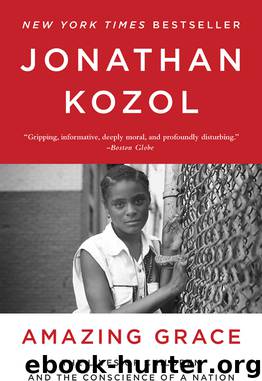Amazing Grace: The Lives of Children and the Conscience of a Nation by Jonathan Kozol

Author:Jonathan Kozol [Kozol, Jonathan]
Language: eng
Format: epub
Tags: Social Science, Sociology, Poverty & Homelessness, Urban
ISBN: 9780770436650
Publisher: Broadway
Published: 2012-06-26T00:00:00+00:00
CHAPTER FIVE
Despite the fact that the just are dying with the unjust, wrote Cyprian, the bishop of Carthage, at the time of an epidemic there in A.D. 251, “it is not for you to think that the destruction is a common one for both the evil and the good. The just are called to refreshment, the unjust are carried off to torture.” The plague, he wrote, “examines the mind of the human race” and “searches out the justice of each and every one.”
Consolations of this nature, however, have not always been persuasive to the victims of a plague. “God’s justice” often seems “far to seek” in the way that a plague spares some and kills others, notes William McNeill, a distinguished historian at the University of Chicago whose classic study of this subject, written 20 years ago, was brought to my attention by a woman in New York who works with adolescents who have AIDS.
In speaking of the Black Death of the fourteenth century and similar periods of pestilence across the centuries, McNeill remarks on “the disruptive effect” of an epidemic, which, he says, is “likely to be greater than … mere loss of life.” Particularly when the highest toll is taken upon young adults, survivors often “lose all faith in inherited custom and belief.”
Population losses “within the 20 to 40 age bracket,” he believes, are “far more damaging” in this respect than “destruction of either the very young or the very old.” Indeed, he writes, “any community that loses a substantial percentage of its young adults … finds it hard to maintain itself materially” or “spiritually.” These words were written in the middle of the 1970s, about ten years before the full effects of AIDS and crack-cocaine addiction had been seen among black and Hispanic men and women in New York and just before the vast expansion in the city’s prison population had begun. We may wonder what McNeill would say about these matters now if he were to visit in Mott Haven or go out to spend a day with inmates on the prison island that is clearly visible from many rooftops here.
Rikers Island—“a 415-acre Alcatraz in the East River” where, says the Times, “92 percent of the captive population is black or Hispanic”—was erected largely on compacted trash and stands less than 1,000 yards across the water from the Hunts Point Sewage Treatment Plant and about two miles north and east of the narrow water passageway called Hell Gate. Passengers departing La Guardia for Boston on the Delta shuttle get a good view of the island if they’re sitting on the left side of the plane, though few may know that what they see beneath them is the largest penal institution in the world, serving some of the most damaged human products of the largest ghetto population in America.
The city spends $58,000 yearly on each adult inmate, $70,000 on each juvenile—nearly ten times what it spends to educate a child in its public schools.
“The cost is justified,”
Download
This site does not store any files on its server. We only index and link to content provided by other sites. Please contact the content providers to delete copyright contents if any and email us, we'll remove relevant links or contents immediately.
| Anthropology | Archaeology |
| Philosophy | Politics & Government |
| Social Sciences | Sociology |
| Women's Studies |
The Secret History by Donna Tartt(18845)
The Social Justice Warrior Handbook by Lisa De Pasquale(12141)
Thirteen Reasons Why by Jay Asher(8793)
This Is How You Lose Her by Junot Diaz(6794)
Weapons of Math Destruction by Cathy O'Neil(6143)
Zero to One by Peter Thiel(5685)
Beartown by Fredrik Backman(5596)
The Myth of the Strong Leader by Archie Brown(5425)
The Fire Next Time by James Baldwin(5248)
How Democracies Die by Steven Levitsky & Daniel Ziblatt(5128)
Promise Me, Dad by Joe Biden(5087)
Stone's Rules by Roger Stone(5026)
A Higher Loyalty: Truth, Lies, and Leadership by James Comey(4843)
100 Deadly Skills by Clint Emerson(4840)
Rise and Kill First by Ronen Bergman(4702)
Secrecy World by Jake Bernstein(4644)
The David Icke Guide to the Global Conspiracy (and how to end it) by David Icke(4625)
The Farm by Tom Rob Smith(4435)
The Doomsday Machine by Daniel Ellsberg(4416)
